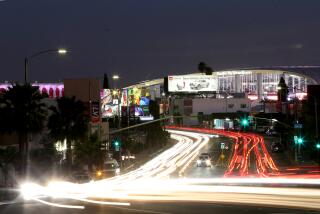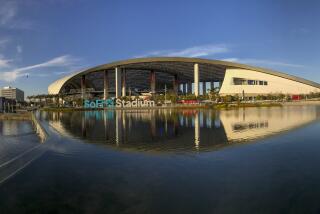Time capsules reveal a different Inglewood
- Share via
It was just a box filled with a bunch of papers when Inglewood sanitation superintendent Harry Frisby sealed and buried it more than three decades ago.
But by the time his son Harry Frisby Jr. unearthed and cracked open the time capsule Thursday, the contents had become mildew-smelling history.
The capsule from 35 years ago, and another from 50 years ago, were opened last week in a ceremony marking the South Bay city’s centennial anniversary.
“For me, it’s personal history as well,” said Frisby, recalling his father, who helped bury the two time capsules in a marble case in front of City Hall when the building was constructed in 1973. His father died of cancer in 1995, and Frisby, born and raised in Inglewood, followed in his father’s footsteps as a city public works superintendent.
On Valentine’s Day, city officials opened the boxes before a large crowd of residents to find snapshots of a drastically different past and confident predictions of a thriving 21st century Inglewood.
For an entire year leading up to the grand unveiling, planners scoured clerk’s records, libraries and people’s memories for information on what they might find in the time capsules. When that proved unsuccessful, city officials resorted recently to shaking the decades-old boxes to confirm there was something inside.
As parks and recreation Director Sabrina Barnes put it, “You don’t want to have a Geraldo Rivera moment.”
In a City Hall plaza decked with red, orange and yellow balloons and streamers, Inglewood residents swarmed around as city officials pried open the two metal boxes. People strained to get a glimpse of what Inglewood citizens of a bygone era had left behind.
First up was the 1973 capsule. Something crumbled between the fingers of a City Council member, and people gasped. But it was only the plastic that wrapped the documents, which were in good shape.
Officials held up a Hollywood Park racing program. A chamber of commerce buyer’s guide. A 1973 article from The Times, “ ‘Overbuilt’ City Hall to Be Dedicated,” which pointed out that the building came “complete with sauna.”
“Proves we’ve always had bad press,” Councilwoman Judy Dunlap said.
A note to the future, in an August 1973 issue of “Views of Inglewood,” trumpeted this: “Attention: 21st Century residents. Inglewood, by 2010, should be the most highly sophisticated mixture of sound business and industrial development with all the amenities for good living to be found in Southern California.”
“I have seen Inglewood grow since then, and I’m proud of it,” said Beverly Frisby, Harry junior’s mother, who remembered the Inglewood of 1973. “It’s done real good.”
There were also signs of emerging urban issues. A survey found that four out of five Inglewood citizens listed crime as the city’s top problem; a previous survey had indicated that noise pollution was the biggest issue.
Local newspaper photos of the 1958 Golden Anniversary celebration showed an entirely white crowd, a contrast to today’s half-black, half-Latino city.
A fading photo showed Inglewood with large, provincial homes and a sign advertising gasoline for 13 1/2 cents. A photo of a 1932 City Council meeting showed mustachioed men sitting stiffly with their top hats. A master parking plan boasted of $54,566 earned in parking meter fines over the last year.
“Histories of cities are the biographies of the men and women that live there,” Robert S. Hartman, president of the Inglewood Golden Anniversary Assn., had written in a letter to future generations. “We are certain that you and your contemporaries have added to the greatness, the strength, the influence of Inglewood and we felicitate you now, fifty years in advance,” he wrote.
Louise Meham, who has lived in Inglewood since 1944, recalled a very different city. “It was a new housing tract back then, during the war,” she said.
Meham wistfully described the city of her memory, where boys rode around town on horseback between bean fields and farmhouses.
On nearby Manchester Boulevard, cutting through modern-day Inglewood, traffic steadily whizzed by.
More to Read
Sign up for Essential California
The most important California stories and recommendations in your inbox every morning.
You may occasionally receive promotional content from the Los Angeles Times.














